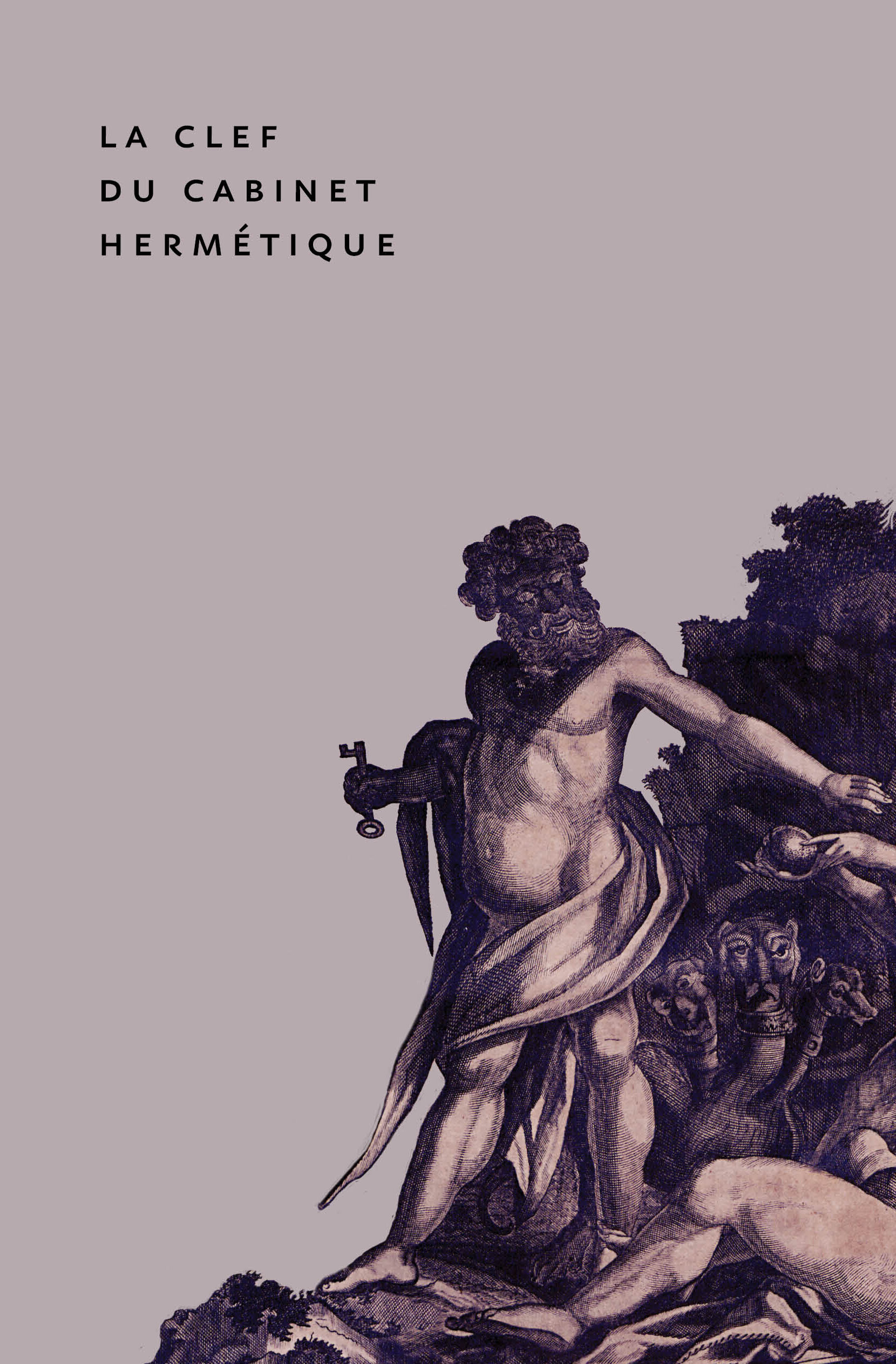
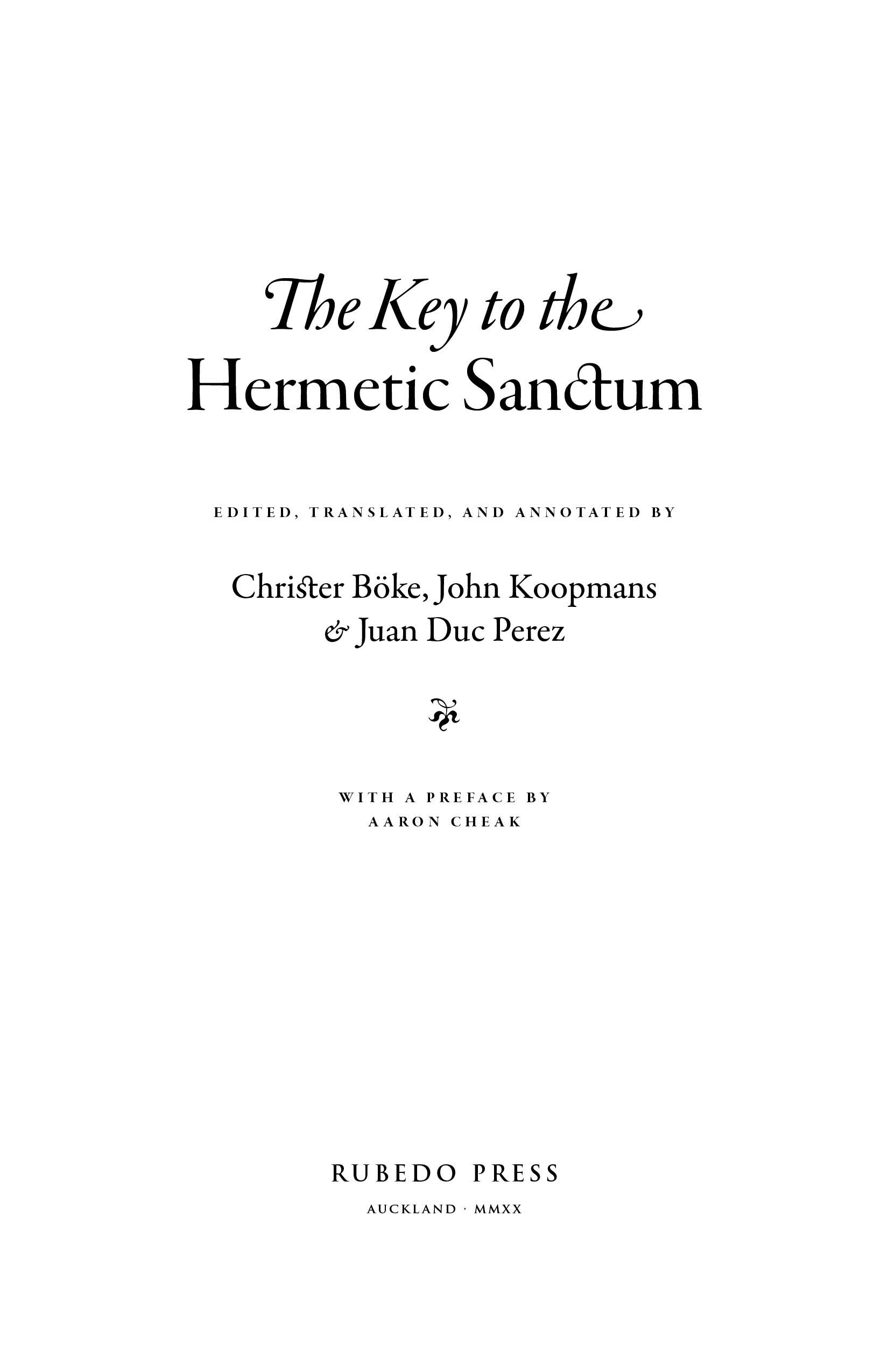

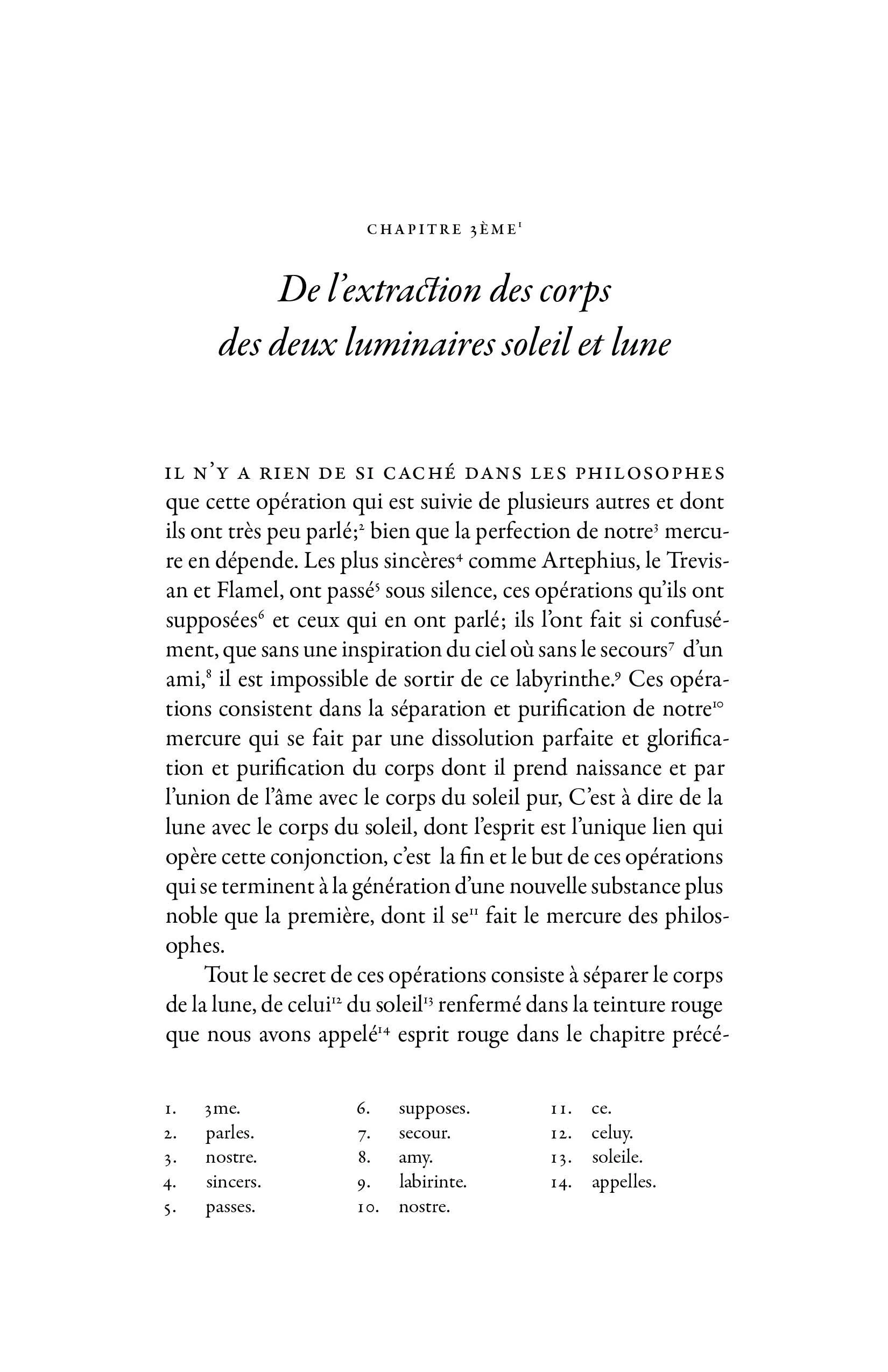
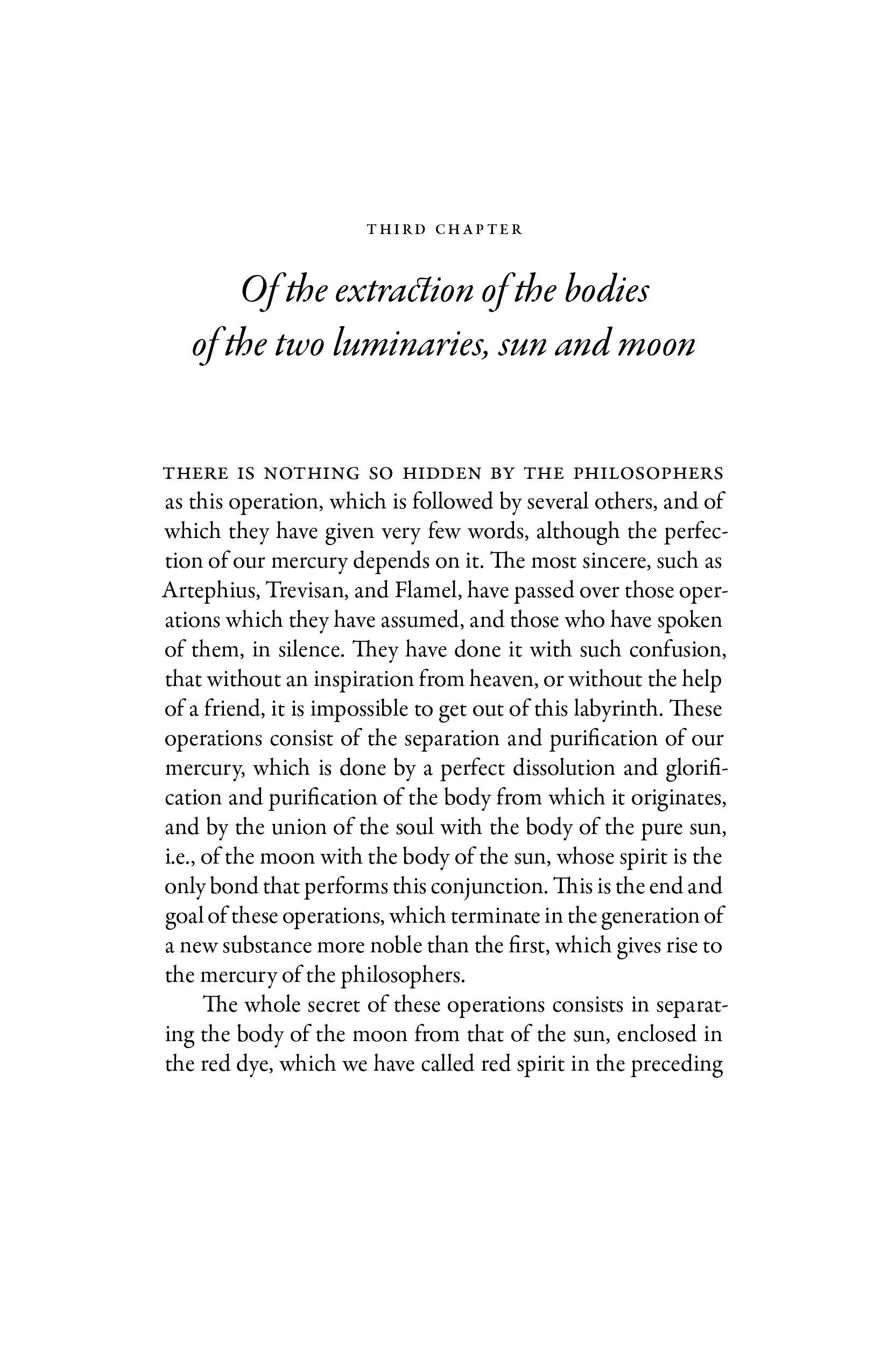
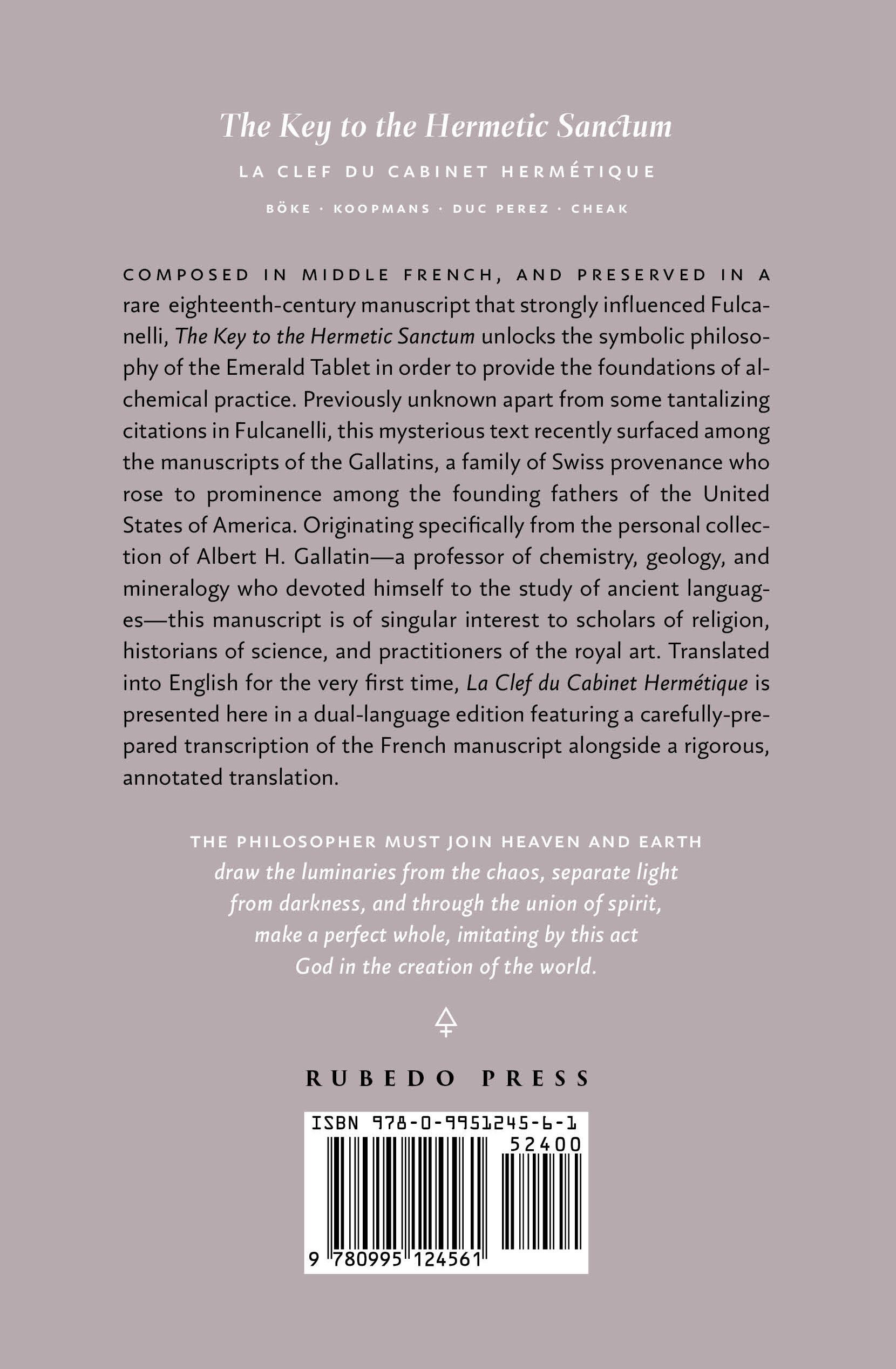
Auckland: Rubedo Press, 2020
Softcover | 5.5 x 8.5 | B&W | 250 pp.
now AVAILABLE
$34.00
Price listed in New Zealand Dollars.
Approximate price in other currencies:
GBP £18.00 , EU: € 19.00, USD $25.00
The Key to the Hermetic Sanctum
La Clef du Cabinet Hermétique
Bilingual edition
Edited & translated by Christer Böke, John Koopmans, & Juan Duc Perez, With a Preface by Aaron Cheak
COMPOSED in Middle French, and preserved in an eighteenth-century manuscript which strongly influenced Fulcanelli, The Key to the Hermetic Sanctum presents itself with a singular purpose: to unlock the symbolic philosophy of the Emerald Tablet in order to provide the foundations of alchemical practice.
Previously unknown apart from some captivating citations from Fulcanelli, this mysterious text recently surfaced among the manuscripts of the Gallatins, a family of Swiss provenance who rose to prominence among the founding fathers of the United States of America. Originating specifically from the personal collection of Albert H. Gallatin—a professor of chemistry, geology, and mineralogy who devoted himself to the study of ancient langauges in order to understand alchemical texts—this manuscript is of singular interest to scholars of religion, historians of science, and practitioners of the royal art.
Translated into English for the very first time, The Key to the Hermetic Sanctum (La Clef du Cabinet Hermétique) appears here in a dual-language edition featuring a carefully prepared edition of the French text alongside a clear English translation. This copiously annotated volume comes with an introduction exploring the figure of Gallatin and his possible connections to Fulcanelli—one of the twentieth century’s most enigmatic alchemists—together with an appendix clarifying the relationship of this work to other texts known under similar names.
The philosopher must join heaven and earth, draw the luminaries from the chaos, separate light from darkness, and through the union of spirit, make a perfect whole, imitating by this act God in the creation of the world.
—The Key to the Hermetic Sanctum—
Table of Contents
Preface
Aaron Cheak, PhD
Introduction
Christer Böke, John Koopmans, Juan Duc Perez
Transcription and Translation
La Clef du Cabinet Hermétique | The Key to the Hermetic Sanctum
Première partie | First part
Avant-propos | Foreword
De la matière en général | Of matter in general
De la matière en particulier | Of matter in particular
De la préparation des Eléments et de leur séparation en géneral | Of the preparation of the elements and their separation in general
Des Eléments en particuliers et de leur préparation | Of the elements in particular and their preparation
Des opérations en général | Of operations in general
Partie deuxième | Second part
Avant-propos: Des opérations en particulier qui sont absolument nécessaires pour la pratique | Foreword: Of the operations in particular which are absolutely necessary for the practice
De l’extraction des teintures | Of the extraction of the tinctures
De la séparation des éléments | Of the separation of the elements
De l’extraction des corps des deux luminaires soleil et lune | Of the extraction of the bodies of the two luminaries, sun and moon
De la Conversion des éléments et la conjonction des deux luminaires, la lune et le soleil | Of the conversion of the elements and the conjunction of the two luminaries, the moon and the sun
Du mercure des philosophes | Of the mercury of the philosophers
De la séparation et purification des principes de notre mercure
en général | Of the separation and purification of the principles of our mercury in generalDe la Composition du grand dissolvant et du mercure des philosophes | Of the composition of the great solvent and the mercury of the philosophers
Table de ce qui est contenu dans ce manuscrit, qui peut servir d’instruction abrégée | Table of what is contained in this manuscript, which can serve as an abridged instruction
Appendix: How many Hermetic Cabinets?
Christer Böke, John Koopmans, Juan Duc Perez
Bibliography
About the Contributors
Christer Böke (MA, History and Theology) has been researching the history of alchemy for the past two decades. His major interest lies in reconstructing alchemical theories from an experimental perspective. Christer wrote his Masters thesis (Lund, 2002) on the ‘Paracelsus dispute’ (1707–1708) between the Swedish chymists, Urban Hjärne and Magnus Gabriel von Block, triggered by the infamous Paykull affair—a topic he further covered during ‘On the Fringes of Alchemy’, a workshop held with different scholars in Budapest 2010. Christer participated in the Swedish translation and commentary of Fulcanelli’s Le Mystère des cathédrales (Katedralernas mysterium, 2013), was featured in the documentary Alkemistens År: The Great Work (2013), and acted as a peer-reviewer on Carl-Michael Edenborg’s alchemical fiction drama, Alkemistens dotter (2014). Together with John Koopmans, he edited and translated Hermetic Recreations, published in 2017 by Rubedo Press.
John Koopmans (BA, Hons, Geography) is a retired professional Regional Planner/demographer. Over the years, he has collaborated in, or contributed to, a number of books concerning biblical history, and the historical study of grail lore. He has also co-authored an alchemical book, Hermetic Recreations, published in 2017 by Rubedo Press. When he’s not intensely studying alchemy, or transcribing numerous old alchemical texts (many in original handwriting), he continues to maintain a very long, active interest in various studies, including recent and ancient history (civilisations, archæology, religions, sciences, philosophies, esoterica, and mythologies).
Juan Duc Perez is a transcriber and translator who over the years has worked with many other fellow enthusiasts (including present coauthors Christer Böke and John Koopmans) in the transcription and translation of numerous English, Spanish, French, Italian, German, Latin, and Arabic alchemical and chymical texts, many of them unpublished manuscripts. A devoted empiricist, he does not only read about alchemy and chymistry, but invests a great amount of his time and efforts in putting their transmutational assertions to the test. A particular area of interest for him are the experiments and processes that have been put forward specifically and explicitly as proofs of the reality of metallic transmutation in the alchemical and chymical literature of the sixteenth, seventeenth and eighteenth centuries, of which he has already found more than thirty examples.
Aaron Cheak (PhD, Religious Studies) is a scholar of comparative religion, philosophy, and esotericism. Straddling the interstices between integral and Hermetic philosophy, he received his doctorate in 2011 for his thesis on René Schwaller de Lubicz, and served as president of the international Jean Gebser Society from 2013–2015. He has appeared in both academic and esoteric publications, including Light Broken through the Prism of Life (2011), Alchemical Traditions (2013/2021), Diaphany (2015), Octagon (2016), and Lux in Tenebris (2017). As a translator of French, German, and Greek, he is presently bringing a number of important projects to fruition through Rubedo Press.